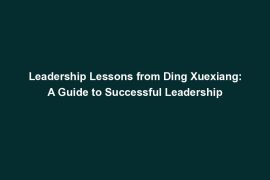Hey there, leadership enthusiasts! Today, we’re diving into the fascinating world of historical leaders and drawing inspiration from the one and only Mao Zedong.
Mao Zedong was a revolutionary figure in Chinese history, known for his strong leadership style and the lasting impact he had on the country. But why should we study historical leaders like Mao? Well, understanding the leadership principles that guided their actions can provide valuable insights and lessons that we can apply in our own lives.
In this blog post, we’ll explore key leadership lessons that we can learn from Mao Zedong. From cultivating a strong vision and mission for the organization, to building a loyal and committed team, and demonstrating adaptability and resilience in the face of challenges, Mao’s leadership style offers a wealth of wisdom for aspiring leaders.
So, get ready to uncover the secrets to effective leadership as we journey through the leadership lessons from Mao Zedong. Stay tuned for some valuable takeaways that you can apply to your own leadership roles!
Cultivating a Strong Vision and Mission for the Organization
Let’s dive into the first leadership lesson we can learn from Mao Zedong – cultivating a strong vision and mission for the organization. Mao’s establishment of the Chinese Communist Party was not just about creating a political group, but about starting a revolution. His vision was clear – to overthrow the ruling Nationalists and establish a communist society in China. This vision galvanized his followers, giving them a sense of purpose and direction.
Think of it like planning a road trip with your friends. You wouldn’t just jump in the car and drive aimlessly, right? You’d have a destination in mind, a vision of where you want to go. Mao did the same with his followers – he gave them a destination to strive towards, creating a shared sense of purpose that kept them moving forward.
Building a Loyal and Committed Team
Now, let’s talk about the importance of building a loyal and committed team, something Mao excelled at. He knew that he couldn’t achieve his vision alone, so he focused on rallying support and building a network of loyal followers. Through his charisma and persuasive skills, Mao was able to inspire trust and loyalty among his team members.
Picture a sports team – the best athletes in the world wouldn’t be able to win championships without a strong team behind them. Mao understood this and worked tirelessly to foster loyalty and commitment among his followers. This sense of unity and camaraderie propelled the Communist movement forward, despite facing numerous challenges along the way.
Adaptability and Resilience in the Face of Challenges
Lastly, let’s explore Mao’s ability to adapt and be resilient in the face of challenges. Throughout his leadership, Mao faced opposition, setbacks, and changing circumstances. But instead of giving up, he pivoted and adjusted his strategies to overcome obstacles.
Think of it like a surfer riding the waves – they can’t control the ocean, but they can adapt their movements to stay balanced and avoid wiping out. Mao did the same, showing us the importance of resilience and adaptability in leadership roles. By being flexible and willing to change course when necessary, leaders can navigate through turbulent times and come out stronger on the other side.
Conclusion
As we wrap up our exploration of the leadership lessons we can learn from Mao Zedong, it is important to reflect on the impact of studying historical leaders on our own leadership practices. By delving into the life and leadership style of Mao, we have gained valuable insights that can be applied to our own roles as leaders in various organizations.
Recap of key leadership lessons learned from Mao Zedong
One of the key lessons we have learned from Mao is the importance of cultivating a strong vision and mission for our organizations. By having a clear goal in mind, we can rally our team members and drive them towards achieving success. Additionally, Mao’s strategies for building a loyal and committed team serve as a reminder of the significance of fostering relationships and building trust among our colleagues.
Moreover, Mao’s adaptability and resilience in the face of challenges highlight the need for leaders to be flexible and able to pivot when necessary. By being open to change and willing to adjust our strategies, we can navigate through obstacles and emerge stronger on the other side.
Reflection on the relevance of studying historical leaders for contemporary leadership practices
Studying historical leaders like Mao Zedong provides us with a wealth of knowledge and wisdom that can be applied to our modern leadership roles. While the world may have changed since Mao’s time, the fundamental principles of leadership remain constant. By learning from the successes and failures of past leaders, we can better equip ourselves to tackle the challenges of the present day.
Encouragement for leaders to apply these lessons in their own leadership roles
As we conclude our discussion, I encourage all leaders to take the lessons learned from Mao Zedong and apply them in their own leadership roles. By cultivating a strong vision, building a loyal team, and being adaptable in the face of challenges, we can drive success and achieve our goals. Let us strive to embody the characteristics of great leaders like Mao, and lead our organizations towards a brighter future.
Thank you for joining me on this journey of exploring leadership lessons from Mao Zedong. I hope you found this discussion insightful and inspiring. Remember, the path to effective leadership is a continuous learning process, and by studying historical leaders, we can enrich our own leadership practices. Here’s to applying these lessons in our own roles and driving success in our organizations!



